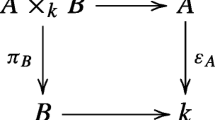Abstract
The toric fiber product is an operation that combines two ideals that are homogeneous with respect to a grading by an affine monoid. The Segre product is a related construction that combines two multigraded rings. The quotient ring by a toric fiber product of two ideals is a subring of the Segre product, but in general this inclusion is strict. We contrast the two constructions and show that any Segre product can be presented as a toric fiber product without changing the involved quotient rings. This allows to apply previous results about toric fiber products to the study of Segre products. We give criteria for the Segre product of two affine toric varieties to be dense in their toric fiber product, and for the map from the Segre product to the toric fiber product to be finite. We give an example that shows that the quotient ring of a toric fiber product of normal ideals need not be normal. In rings with Veronese type gradings, we find examples of toric fiber products that are always Segre products, and we show that iterated toric fiber products of Veronese ideals over Veronese rings are normal.
Similar content being viewed by others
References
Bruns, W., Gubeladze, J.: Polytopes, Rings, and \(K\)-Theory. Springer Monographs in Mathematics. Springer, Heidelberg (2009)
Buczyńska, W., Buczyński, J., Kubjas, K., Michałek, M.: On the graph labellings arising from phylogenetics. Central Eur. J. Math. 11(9), 1577–1592 (2013)
Chen, Y., Dinwoodie, I.H., Sullivant, S.: Sequential importance sampling for multiway tables. Ann. Statist. 34(1), 523–545 (2006)
Chow, W.: On unmixedness theorem. Amer. J. Math. 86(4), 799–822 (1964)
De Loera, J.A., Hemmecke, R., Köppe, M.: Algebraic and Geometric Ideas in the Theory of Discrete Optimization. SIAM, MPS-SIAM Series on Optimization (2013)
Engström, A., Kahle, T., Sullivant, S.: Multigraded commutative algebra of graph decompositions. J. Algebr. Combinat. 39(2), 335–372 (2014)
Sturmfels, B.: Gröbner Bases and Convex Polytopes. University Lecture Series, vol. 8. American Mathematical Society, Providence (1996)
Sullivant, S.: Toric fiber products. J. Algebra 316(2), 560–577 (2007)
Sullivant, S.: Normal binary graph models. Ann. Inst. Stat. Math. 62(4), 716–726 (2010)
Swanson, I., Huneke, C.: Integral Closure of Ideals, Rings, and Modules. LMS Lecture Note Series. Cambridge University Press, Cambridge (2006)
Takemura, A., Thomas, P., Yoshida, R.: Holes in semigroups and their applications to the two-way common diagonal effect model. In: Proceedings 2008 International Conference on Information Theory and Statistical Learning. CSREA Press, USA. pp. 67–72 (2008)
Tousi, M., Yassemi, S.: Tensor products of some special rings. J. Algebra 268(2), 672–676 (2003)
Author information
Authors and Affiliations
Corresponding author
Additional information
Communicated by Bernd Siebert.
Rights and permissions
About this article
Cite this article
Kahle, T., Rauh, J. Toric fiber products versus Segre products. Abh. Math. Semin. Univ. Hambg. 84, 187–201 (2014). https://doi.org/10.1007/s12188-014-0095-5
Received:
Published:
Issue Date:
DOI: https://doi.org/10.1007/s12188-014-0095-5




